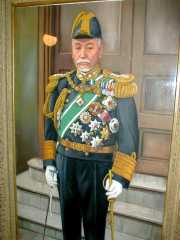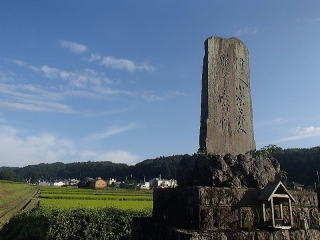| 何をしても正しい軍隊はない 「勝てば官軍」は権力者のおごり No army is right at any cost. "Might is Right" is the Arrogance of the Power. |
|
|---|---|
|
Acknowledgement by Heihachiro Togo ◆ "This shipyard was started by Kozukenosuke Oguri at the end of the Edo period after overcoming great hardships and has been in operation up to now..." In 1915 or Taisho 4, at the 50th anniversary of the Yokosuka Naval Arsenal, (a substitute for) Shigenobu Okuma surprised the attendees by saying the above. They were surprised because they thought that the Meiji government had built it. The construction of the shipyard began in 1865, the first year of Keio, at the end of the Edo period, and the facilities were gradually completed during the Keio years, with full-scale shipbuilding and manufacturing operations starting around 1867 Keio 3 as a comprehensive manufacturing plant. After the Meiji Restoration, it was taken over by the Meiji government along with the unpaid construction costs for the fourth year. However, the government used the shipyard silently without talking about such circumstances, so it is not surprising that people thought so. Ayako, Okuma's wife, is a cousin of Mrs. Michiko Oguri, the wife of Kozukenosuke
Oguri. This greeting came about because Okuma, who was serving as prime
minister of Japan at the time, was having a hard time raising the unpaid
money for the construction of the shipyard, which had been taken over by
the Meiji government. This greeting led the city of Yokosuka to create
busts of Oguri and the French chief engineer, Francois Leonce Verny, as
benefactors through fund-raising. |
|
 小栗家の遺族に礼を述べた東郷平八郎 (記念艦三笠にて・横須賀市) Heihachiro Togo who thanked Oguri's bereaved family (A Frame At the Mikasa Historic Memorial Warship, Yokosuka City) |
|
|
When they were shown into the room, they were told to sit at the seats of honor. When Sadao declined, Togo told him, "You are here in place of Kozukenosuke-san," and forced them to sit on the top seats. Togo said, "We were able to achieve complete victory over the Russian fleet in the Battle of the Sea of Japan thanks to your father, Kozukenosuke, who built the Yokosuka Shipyard. I wanted to express my gratitude to you," and offered them a meal. Afterwards, he wrote a calligraphy of "Jin, Gi, Rei, Chi, Shin (benevolence, justice, gratitude, cleverness, faith)" and presented it to them as a commemorative gift. Since there are no photographs of the meeting between Togo and Oguri's bereaved family, this calligraphy is valuable evidence that Togo thanked Oguri's bereaved family. On the occasion of the 130th anniversary of the Oguri Festival in 1997, the calligraphy was donated to Tozenji Temple by his great-grandson Tadato Oguri, who said, "The best way to restore my great-grandfather's honor is to see this." The great-grandson's words express his feeling that "the honor of my great-grandfather, Tadamasa Oguri, has not yet been restored."
◆勝てば官軍負くれば賊軍、という言葉がある。1917大正6年9月、盛岡藩士を慰霊する「戊辰戦争殉難者五十年祭」に参列した原敬(翌年に第19代総理大臣となる)が、祭文に加えて読んだことで、明治以来の薩長政府権力者の横暴をたしなめる言葉として広まった。 Painstaking efforts to erect a cenotaph in honor of Kozukenosuke Oguri ◆ In 1929, a plan was submitted to the Takasaki Police Station to erect a monument on the riverbank where Oguri was killed, funded by the villagers who mourned his innocent death. At that time, the Japanese government did not allow freedom of expression for fear of criticism of the Meiji government, so such a monument could not be erected unless permission was obtained from the Ministry of Home Affairs. The contact point for the Ministry of Home Affairs was the police department. Soon after, the chief of the Takasaki Police Department called Motokichi Ichikawa, the former mayor of Gonda Village, who was in charge of erecting the monument. The chief told him the following: "The inscription says that the great Kozukenosuke Oguri was killed here without any crime, but it was the government forces that killed him. The government forces were the army of the Emperor, so they would not have cut down an innocent man. Therefore, it is not gentle to say, "He was slain...without sin, so do something about it." ◆ There is a saying, "If you win, you are the government army (Might is Right); if you lose, you are the rebel army." In September 1917 or Taisho 6, Takashi Hara (who would become the 19th Prime Minister the following year) attended the "Boshin War Martyrs' 50th Anniversary" memorial service for the Morioka clan soldiers. He read this in addition to the service text, which became popular as a rebuke to the tyranny of the Satcho government authorities since the Meiji era. Thus, the phrase was originally intended as a rebuke to the arrogance of the victors, saying, "The Meiji government forces just happened to win and become the government forces, but they are doing too much as they please." However, before long, the term was perverted to mean that it did not matter
what the powerful did as long as they won, and it has become the driving
force behind the distortion of government and military power politics since
the Meiji era. The chief's insistence that "something be done (not
accepting it as is)" must have been an extension of this attitude. |
|
 顕彰慰霊碑(倉渕町水沼河原) Cenotaph in honor of Kozukenosuke Oguri (Mizunuma Kawara, Kurabuchi Town) |
|
|
◆ 困った市川元村長は村へ戻ると、碑文を書いた国際法学者蜷川新博士に手紙で報告し相談した。蜷川の母はつ子は小栗上野介夫人道子の妹で、元旗本の家に生まれた蜷川は苦学して国際法を学び国際法学者として同志社大学、駒沢大学で教え、総理大臣田中義一の国際問題顧問をつとめていた。そして昭和初年に著書『維新前後の政争と小栗上野の死』で上野介の無実の死を書き、明治政府の処置を厳しく糾弾していた。 ◆ Motokichi Ichikawa, the former mayor of Gonda Village, returned to the village and wrote to Dr. Arata Ninagawa, the international lawyer who had written the inscription, and consulted with him. Ninagawa's mother, Hatsuko, was the younger sister of Michiko, the wife of Kozukenosuke Oguri. Born into a former hatamoto family, Ninagawa studied international law at school with great financial difficulty and taught at Doshisha University and Komazawa University as an international law scholar, and served as an international affairs advisor to Prime Minister Giichi Tanaka. In the early years of the Showa era, he wrote a book entitled "Political Strife Before and After the Meiji Restoration and the Death of Kozukenoske Oguri," in which he harshly denounced the measures taken by the Meiji government in the case of Oguri's innocent death. Ninagawa soon told Ichikawa, "Wait and see. I will have Giichi Tanaka solve the problem." The chief's story has since been put to rest, and the monument still stands today. (Additions were made to the "Opinion" column of the Jomo Shimbun, July 9, 2000) |
|
|
Please note the Japanese language. The opposite of "kan (the government)" should be "min (the people)." However, since the Western forces raised a false brocade flag at the Battle of Toba-Fushimi, the opposite of "government army" has not been "people's army" but "rebel army." The term "rebel army" has become a judgmental term, meaning an
army that is bad at anything it does. The opposite of "democracy" is "bureaucrat-led politics": The chief's words indicate that the government since the Meiji period has been based on bureaucrat-led politics, with a sense of government-led military.
|
|
| 関連ページ ◆横須賀製鉄所の借款説〈小栗上野介の濡れ衣〉 ◆官軍意識との戦い ◆お殿様のお首級(くび)迎え…小栗上野介父子の首級を盗掘した村人 |
関連ページ ◆ The theory that the Yokosuka ironworks were built with borrowed money (The false accusations against Kozukenosuke Oguri) ◆ The Battle Against Government Consciousness ◆ Welcoming Oguri's head to Tozenji Temple: Gonda villagers stole and retrieved the heads of Kozukenosuke Oguri and his son. |